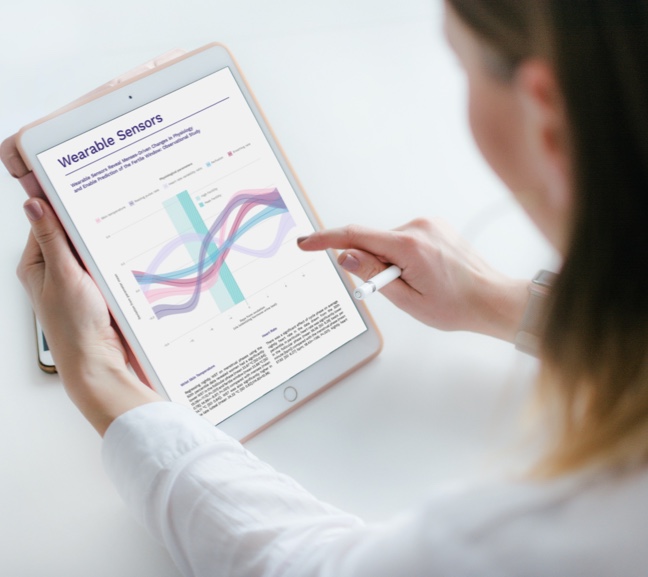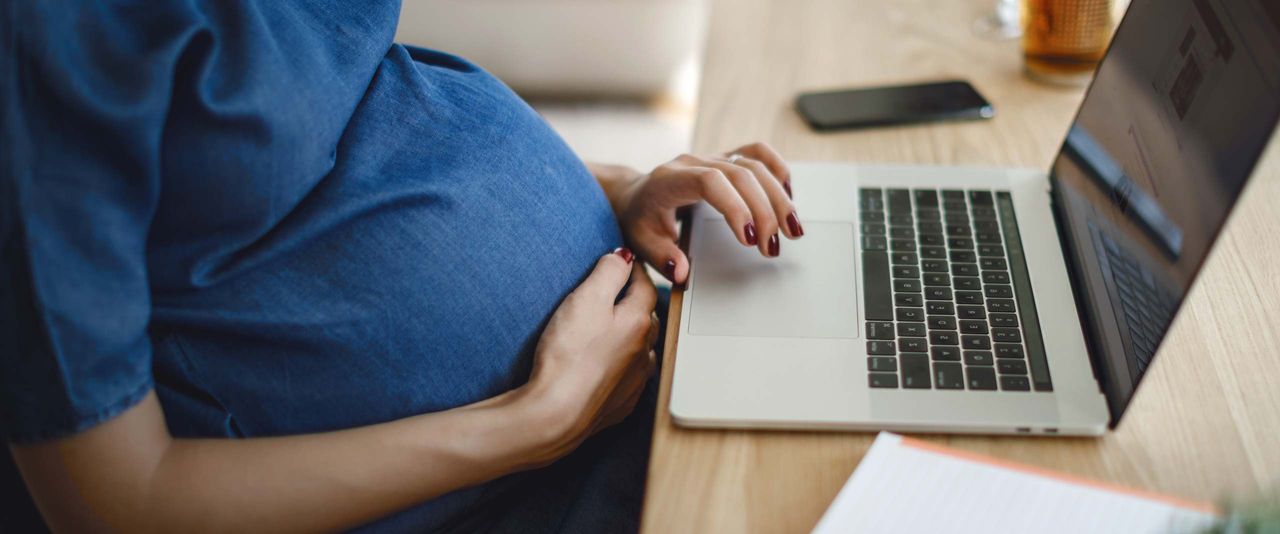Location preferences
Close
Currency
Science drives our products, with more than 30 peer-reviewed publications and presentations at medical Congresses documenting our dedication to research. In developing services that support women across their reproductive lifetimes, we hold ourselves to the highest standards of scientific inquiry.

Journal article
Primary research question: Is wrist skin temperature continuously measured by the Ava bracelet during sleep more accurate than basal body temperature (BBT) in detecting ovulation?
Key findings: Analyses from a prospective diagnostic accuracy study of 193 cycles from 57 eumenorrheic women showed that by using luteinizing hormone test as the reference standard, wrist skin temperature was more sensitive than BBT in detecting ovulation (sensitivity: 0.624 vs. 0.229, P<0.0001), presented as a biphasic temperature shift during mid-cycle. During the postovulatory phase, increase in wrist skin temperature was greater than that in BBT (0.50°C vs. 0.20°C).
Zhu TY, Rothenbühler M, Hamvas G, Hofmann A, Welter J, Kahr M, Kimmich N, Shilaih M, Leeners B. Wrist skin temperature is more sensitive than basal body temperature in detecting ovulation: A prospective comparative diagnostic accuracy study. J Med Internet Res. 2021;23(6);e20710. doi:10.2196/20710
Journal article
Primary Research Question: What significant physiological changes can a wearable device detect across the menstrual cycle, and can we leverage machine learning to predict a woman’s fertile window in real time?
Key Findings: Analyses from a clinical trial (n=237) revealed that the Ava bracelet can detect significant, concurrent phase-based shifts in wrist skin temperature, heart rate, and respiratory rate (all p<.001). These findings were robust to daily, individual, and cycle-level covariates. Furthermore, we developed a machine learning algorithm that can detect the 5-day fertile window with 90% accuracy (95% CI, 0.89 to 0.92).
Goodale BM, Shilaih M, Falco L, Dammeier F, Hamvas G, Leeners B. Wearable sensors reveal menses-driven changes in physiology and enable prediction of the fertile window: Observational study. J Med Internet Res. 2019;21(4):e13404. doi:10.2196/13404.
Journal article
Primary Research Question: Can wearable sensors accurately detect the biphasic shift in core body temperature that occurs during the menstrual cycle? Specifically, how does wrist skin temperature (WST) correlate with urinary tests of ovulation?
Key Findings: Eumenorrheic women (n=136) wore the Ava bracelet while sleeping and took urinary LH tests to confirm ovulation. A sustained 3-day temperature shift was observed in 357/437 cycles (82%), with most temporal shifts (307/357, 86%) occurring on ovulation day or later. Phase-based changes in WST were impervious to lifestyle factors that previously have been shown to obfuscate basal body temperature readings.
Shilaih M, Goodale BM, Falco L, Kübler F, De Clerck V, Leeners B. Modern fertility awareness methods: Wrist wearables capture the changes in temperature associated with the menstrual cycle. Biosci Rep. 2018;38(6):BSR20171279. doi:10.1042/BSR20171279.
Journal article
Primary Research Question: This study investigated how a woman’s pulse rate changes across the menstrual cycle and correlates with the fertile window, as measured at home during sleep using the Ava bracelet.
Key Findings: Two hundred seventy-four ovulatory cycles were recorded from 91 participants, with a mean cycle length of 27.3 days (±2.7). Pulse rate (PR) significantly increased during the fertile window compared to menses (2.1 beat-per-minute, p< 0.01). Moreover, PR during the mid-luteal phase was also significantly elevated compared to the fertile window (1.8 beat-per-minute, p< 0.01) and menses (3.8 beat-per-minute, p< 0.01).
Shilaih M, De Clerck V, Falco L, Kübler F, Leeners B. Pulse rate measurement during sleep using wearable sensors, and its correlation with the menstrual cycle phases, a prospective observational study. Sci Rep. 2017;7(1):1294. doi:10.1038/s41598-017-01433-9.
Poster Presentations
Primary research question: Is the Ava Fertility tracker as accurate as urinary Luteinizing Hormone (LH) tests in detecting ovulation?
Key findings: Using machine learning, the Ava Fertility tracker detected the day of ovulation in 205 menstrual cycles from 61 women with a mean error of 0.31 days (95% CI, -0.13 to 0.75) compared to LH tests. Furthermore, the wearable device predicted ovulation correctly ahead of time in 87% of all ovulatory menstrual cycles. As accurate as LH tests, the Ava Fertility tracker provides a larger prospective fertile window thereby enabling women to increase their chances of conceptive sex.
Zhu TY, Goodale BM, Cronin M, Rothenbühler M, Leeners B. Accuracy of a wrist-worn medical device to identify fertile window and ovulation day. Fertility and Sterility. 2021;116(3):e292. Poster presented at: American Society of Reproductive Medicine Scientific Congress and Expo; October 17-20, 2021; Baltimore, MD, USA.
Poster Presentations
Primary Research Question: How can a wearable fertility device help subfertile women conceive and serve as an employer-subsidized alternative to fertility treatments?
Key Findings: Ava Fertility tracker users (n=1756) completed an online survey about their trying to conceive journey and fertility service usage. Most women undergoing fertility treatments (76%) relied on their own insurance. Employers who offered Ava as a covered benefit were perceived positively, with 56% of respondents indicating that it would positively impact their likelihood of joining or staying at a company. These results suggest that wearable devices can serve as an easy-to-use, cheap, and attractive employer-covered fertility benefit.
Goodale, BM, Blaivas, M. Real-world perspective on wearable sensor technology as a complement to traditional fertility services and an employer-covered benefit. Fertility and Sterility. 2021;116(3):e268. Poster presented at: American Society of Reproductive Medicine Scientific Congress and Expo; October 17-20, 2021; Baltimore, MD, USA.
Poster Presentations
Primary Research Question: Can physiological parameters measured by a wearable device predict intraamniotic infection in pregnant women with preterm premature rupture of membranes (PPROM)?
Key Findings: We found that the Ava bracelet could be used to detect significant differences in breathing and heart rate (HR) in the 3 days preceding birth between hospitalized women with (n=19) and without (n=25) intraamniotic infection. Women with intraamniotic infection had a significantly higher breathing rate (19 breaths per minute) and HR (72 beats per minute [bpm]), compared to women without infection (16 breaths per minute, p=.001; 67 bpm, p=.03). This proof-of-concept study suggests wearable sensors could support non-invasive infection detection among pregnant women.
Brun R, Girsberger J, Rothenbühler M, Argyle C, Hutmacher J, Haslinger C, & Leeners B. Wearable sensors for prediction of intraamniotic infection in women with PPROM. Poster presented at: Annual Congress of the Swiss Society of Gynaecology and Obstetrics; June 24-26, 2021; Interlaken, Switzerland.
Oral Presentations
Primary Research Question: Can a fully wearable system using photoplethysmography provide reliable estimations of heart rate and breathing rate during the night, compared to data from polysomnography (the gold standard of sleep studies)?
Key Findings: For four nights, each participant (n=7) wore two Ava bracelets as well as a complete polysomnographic setup while sleeping to obtain reference signals. The resulting mean absolute errors for the wearable device compared to polysomnography data were less than one breath-per-minute for breathing rate, less than one beat-per- minute for heart rate, and around 17 ms for the beat-to-beat intervals.
Renevey P, Delgado-Gonzalo, Lemkaddem A, et al. Respiratory and cardiac monitoring at night using a wrist wearable optical system. In: 2018 40th Annual International Conference of the IEEE Engineering in Medicine and Biology Society (EMBC). IEEE; 2018:2861-2864.
Oral Presentations
Primary Research Question: This study evaluates the use of wearable devices, with reference to clinical measurements, in assessing the association of sleep patterns and quality with menstrual cycle phases.
Key Findings: We recorded 541 cycles from 181 women. Total sleep time did not change across the menstrual cycle. However, deep sleep lasted significantly longer in the follicular and early luteal phases, and was shorter around menstruation. Women also woke up more often during the luteal phase. We consider the effect of potential covariates in our analyses (e.g., alcohol or caffeine intake).
Shilaih M, Falco L, Kübler F, Hamvas G, Cronin M, Leeners B. Monitoring sleep patterns change across the menstrual cycle using wearable sensors. Paper presented at: International Federation of Gynecology and Obstetrics 2018 World Congress; October 14-19, 2018; Rio de Janeiro, Brazil.
Striving to make Ava a global leader in the field of women’s health, our scientists are pursuing projects related to:
Ava is Interested in clinical and research cooperation in gynecology, obstetrics, and adjacent fields.
Please contact our Director of Medical Affairs, Brianna Mae Goodale, if you are interested in a research or clinical collaboration.
Ava abides by the General Data Protection Regulation (GDPR), the highest security standard in both the European Union and the United States, and employs region-specific servers for data storage through Amazon Web Services (AWS). All user data is stored anonymously with the individual’s user ID, registration info, and other PII stored separately.
